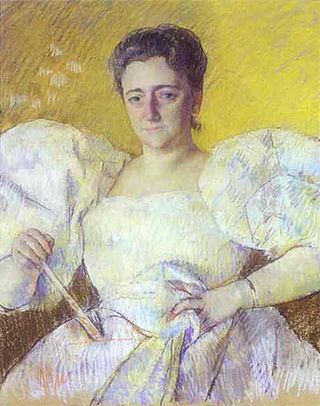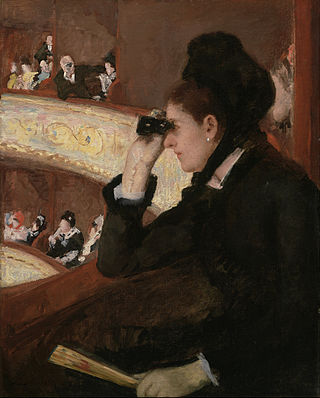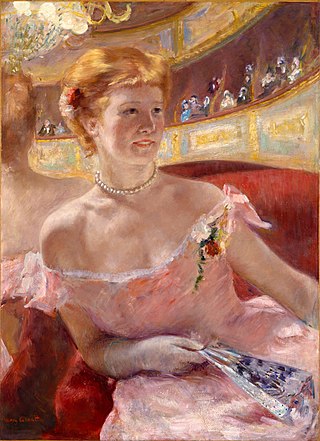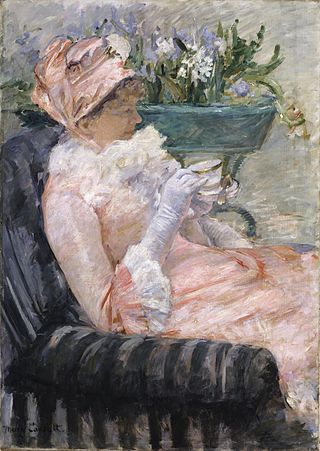
Mary Stevenson Cassatt was an American painter and printmaker. She was born in Allegheny, Pennsylvania, but lived much of her adult life in France, where she befriended Edgar Degas and exhibited with the Impressionists. Cassatt often created images of the social and private lives of women, with particular emphasis on the intimate bonds between mothers and children.

Edgar Degas was a French Impressionist artist famous for his pastel drawings and oil paintings.

The Little Fourteen-Year-Old Dancer is a sculpture begun c. 1880 by Edgar Degas of a young student of the Paris Opera Ballet dance school, a Belgian named Marie van Goethem.

Louisine Waldron Elder Havemeyer was an art collector, feminist, and philanthropist. In addition to being a patron of impressionist art, she was one of the more prominent contributors to the suffrage movement in the United States. The impressionist painter Edgar Degas and feminist Alice Paul were among the renowned recipients of the benefactor's support.

Feminist art is a category of art associated with the late 1960s and 1970s feminist movement. Feminist art highlights the societal and political differences women experience in their lives. The hopeful gain from this form of art is to bring a positive and understanding change to the world, in hope to lead to equality or liberation. Media used range from traditional art forms such as painting to more unorthodox methods such as performance art, conceptual art, body art, craftivism, video, film, and fiber art. Feminist art has served as an innovative driving force towards expanding the definition of art through the incorporation of new media and a new perspective.

The Child's Bath is an 1893 oil painting by American artist Mary Cassatt. The painting continues her interest in depicting bathing and motherhood, but it is distinct in its angle of vision. Both the subject matter and the overhead perspective were inspired by Japanese Woodcut prints and Edgar Degas.

Bracha Lichtenberg Ettinger is an Israeli artist, painter and writer, visual analyst, psychoanalyst and philosopher, living and working in Paris and Tel Aviv. She is regarded as a major French feminist theorist and prominent international artist in contemporary New European Painting, that invented the concepts Matrixial Gaze, matrixial (matricial) space / espace matrixiel (matriciel). Ettinger is a professor at European Graduate School in Saas-Fee, Switzerland and at GCAS, Dublin.

Griselda Frances Sinclair Pollock is an art historian and cultural analyst of international, postcolonial feminist studies in visual arts and visual culture. Since 1977, Pollock has been an influential scholar of modern art, avant-garde art, postmodern art, and contemporary art. She is a major influence in feminist theory, feminist art history, and gender studies. She is renowned for her innovative feminist approaches to art history which aim to deconstruct the lack of appreciation and importance of women in art as other than objects for the male gaze.
Mary Kelly is an American conceptual artist, feminist, educator, and writer.

In The Loge, also known as At The Opera, is an 1878 Impressionist painting by the American artist Mary Cassatt. The oil-on-canvas painting is currently in the Museum of Fine Arts, Boston, which also holds a preliminary drawing for the work. The painting displays a bourgeois woman at the opera house looking through her opera glasses, while a man in the background looks at her. The woman's costume and fan make clear her upper class status. Art historians see the painting as commentary on the role of gender, looking, and power in the social spaces of the nineteenth century.

M. Knoedler & Co. was an art dealership in New York City founded in 1846. When it closed in 2011, amid lawsuits for fraud, it was one of the oldest commercial art galleries in the US, having been in operation for 165 years.

Little Girl in a Blue Armchair is an 1878 oil painting by the American painter, printmaker, pastelist, and connoisseur Mary Cassatt. It is in the collection of the National Gallery of Art, Washington D.C. Edgar Degas made some changes in the painting.
Warren Adelson is an American art dealer, art historian, and author specializing in 19th and 20th-century American Painting as well as contemporary art.

Gardner (Cassatt) Held by His Mother is a drypoint print dated circa 1889 by the American painter, printmaker, pastelist, and connoisseur Mary Cassatt. The example illustrated is in the collection of the Cooper-Hewitt Museum and is a gift of Samuel Putnam Avery.

Woman with a Pearl Necklace in a Loge is an 1879 painting by American artist Mary Cassatt. The Philadelphia Museum of Art acquired the painting in 1978 from the bequest of Charlotte Dorrance Wright. The style in which it was painted and the depiction of shifting light and color was influenced by Impressionism. This painting shows a view of the modern woman and is similar in style to Degas.

The Boating Party is an 1893 oil painting by American artist Mary Cassatt. It has been in the collection of the National Gallery of Art since 1963.

Mother and Child (The Oval Mirror) is an oil-on-canvas painting by Mary Cassatt. The painting depicts a mother and her child in front of a mirror. The painting provides a glimpse of the domestic life of a mother and her child, evoking religious iconography from the Italian Renaissance. However, portrayals of a mother and her child are common in Cassatt's work, so it is possible that this similarity is coincidental rather than intentional.

The American artist Mary Cassatt painted The Cup of Tea in Paris ca. 1879–1881. The painting depicts Mary’s sister Lydia Cassatt in a typical, upper class-Parisian ritual of afternoon tea. Scholars have observed that Cassatt’s choice to employ vivid colors, loose brushstrokes, and unique perspective to portray the scene makes it a quintessentially Impressionist painting.

Woman with a Sunflower is a 1905 oil painting by the American artist Mary Cassatt. It has been in the collection of the National Gallery of Art in Washington, DC since 1963.

The Tea, also referred to as Five O’Clock Tea, is an oil-on-canvas painting of two women having tea by the American Impressionist painter Mary Cassatt. The role of gender in the painting has been the subject of differing interpretations among art historians. Griselda Pollock describes the confined interior as an evocation of the spatial and social constraints placed on women at the time. Norma Broude asks whether the work might contain "possibilities for empowerment," showing the agency that women exercised through sociability. And John Loughery argues that the intention behind Cassatt's work might always remain a mystery.



















